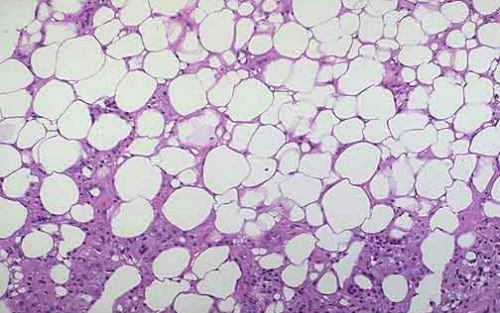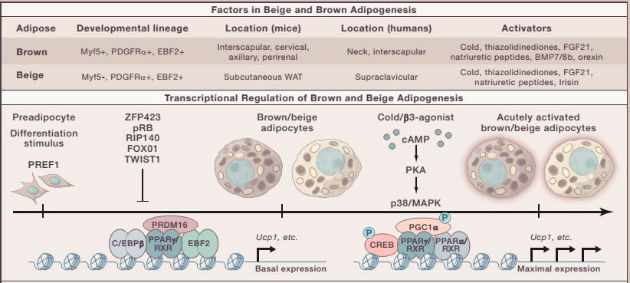Introduction | Cell "SnapShot: Brown and Beige Adipose Thermogenesis", describes the regulation of transcription and Development beige brown adipose tissue and adipose tissue , as well as two key mechanisms of tissue thermogenesis physiologically active factors and pharmacological activity factor . |

Mammals
(including humans and mice) have two distinct fat, white fat and brown
fat. White fat is responsible for storing excess energy for a rainy day,
brown fat cells burn fat will be converted into heat. Brown fat in the
human body is divided into two categories, typical brown fat (Brown
Adipose) and third category of fat cells (adipocytes beige, beige
Adipose).
White fat stores energy in the form of triglycerides, and, depending on their location in the body, may have a negative effect on health, leading to insulin resistance, metabolic syndrome and type 2 diabetes. Morphology and function of brown fat cells are different, can be stored as fat burning energy while consuming glucose. Beige fat cells burn energy, can be embedded in white adipose tissue. Because these fats play an important role in various diseases, so by the scientists' attention.
Cell "SnapShot: Brown and
Beige Adipose Thermogenesis", describes the regulation of transcription
and Development beige brown adipose tissue and adipose tissue, as well
as two key mechanisms of tissue thermogenesis physiologically active
factors and pharmacological activity factor.

Weight control immune cells
Researchers in the past few years only began to understand the mechanisms of the immune system affect metabolism and weight control. This may sound surprising, because most of the known functions of the immune system that helps the body fight off infection. But from an evolutionary perspective, this makes sense. Although the immediate task of the immune system that fight infection, it is conceivable some elements have evolved to the adipose tissue in the face of adversity and "communication", thus changing metabolism ability.
A group of researchers found that, compared to thin people, obese adults belly fat is not a common type known as ILC2s immune cells. And in some mice, they found ILC2s seem to promote the "beige" (beige) fat cell formation, which is known to improve the body's calorie burning.
Scientists have long sought a way to be able to increase brown fat. But in addition to the body white fat and brown fat, but there is a third type of fat - the so-called beige fat. Like brown fat as beige fat can burn calories and generate heat. More importantly, it is possible to prevent obesity plays an important role.
Mitochondria and adipose tissue
Beige and brown adipose tissue can breathe the chemical energy into heat dissipated by the heat, this process requires uncoupling protein 1 (UCP1). Thermogenic effect of these fat cells can cope with obesity and diabetes, which encouraged the study of the body that controls breathing UCP1-dependent factors.
A study this year showed that brown adipose tissue in acute activation of thermogenesis has decided to significantly increase mitochondrial reactive oxygen species (ROS). Notably, this process (ROS increase process) supports the body heat production because of the depletion of mitochondrial ROS cause hypothermia and pharmacological inhibition of UCP1-dependent enhancement of the energy consumption of the body at the time of cold exposure. We further establish, change ROS thermogenesis of brown adipose tissue cysteine thiol redox state, in order to enhance the driving respiration, and the UCP1 cysteine 253 is the key target. UCP1 the 253 cysteine thermogenesis process of being sulfinyl, and mutation of this site causes the state vector by inhibition of purine nucleotide adrenergic activation uncoupling desensitization. These studies identified brown adipose tissue mitochondria induced ROS is to support UCP1-dependent mechanism thermogenesis and energy consumption of the body, which was found to improve therapeutic strategies against metabolic disorders open up the road.
Original article:
SnapShot: Brown and Beige Adipose Thermogenesis
DOI: http://dx.doi.org/10.1016/j.cell.2016.06.038
Souce: NovoPro 2016-07-08
